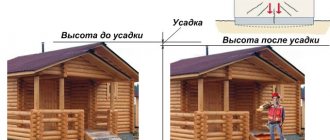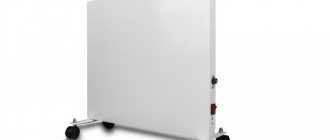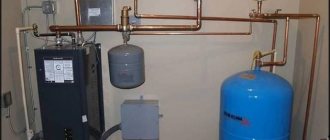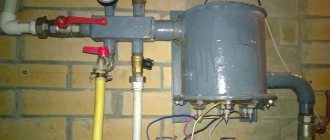Operating principle of infrared heating
IR radiation is electromagnetic waves that are invisible to the human eye. These waves are also called “thermal”; this is exactly how they affect our perception, and even more so, thermal radiation from the sun works in the same way. The peculiarity of this radiation is that it does not heat the air, but it warms objects - people, animals, furniture, floors. As objects cool down, they give off heat to the air. This ensures a comfortable temperature in the room. The sun heats according to the same principle. It does not heat the air, but objects, which in turn give off heat. And since the sun is not dangerous for living organisms, the same can be said about infrared heating. With proper installation and operation, a person will not feel any negative effect from its use.
Operating principle
Infrared heaters differ from convective heaters in their operating principle - they do not heat the surrounding air mass, the radiation heats objects in the area of operation of the unit. And the already heated floor, walls and furniture release heat into the air. Since solid bodies shield the waves emitted by the heater, the floor under the table in their path will not warm up, but the heated table itself will release the resulting heat in all directions. Although comparing infrared heaters with the sun is more of a marketing ploy, their radiation spectrum characteristics are similar.
Advantages of infrared heating
The most important advantage of IR technology is that this heating method is extremely economical. While with traditional central heating you need to heat the entire room to warm the people in it, the IR source warms the person and the objects around him. It works immediately after switching on, the room does not need to be preheated. Take a close look at these numbers:
- To heat a room of 16 square meters using an IR source, you need 900 W.
- To heat the same room using an electric heater you need 2 - 2.5 kW.
The numbers speak for themselves.
In addition to saving and rational use of energy, this technology has a number of advantages:
- No radiators or pipes: no problems with freezing or leakage;
- The air is not dried out, oxygen is not burned;
- No need to spend money on periodic restoration or maintenance;
- Long service life - 30-50 years;
- Safety: you are not at risk of fire or electric shock;
- No possibility of accidental injury and burns;
- There is no need to ventilate or install a chimney - there are no combustion products;
- Absolutely silent operation (unlike a boiler or water circulation in a central heating system);
- Minimum amount of space occupied in the room;
- There is no negative impact on the environment because there is no waste;
- During operation, no convection currents are created that move dust indoors;
- The microclimate in the room is stably maintained at a given level, regardless of the weather;
- Possibility of creating several temperature zones in one room;
- Sudden temperature changes in height are excluded (in traditional heating, the temperature in the floor area is significantly lower);
- Possibility of full automation and use of remote control;
- Light weight, easy to transport, simple installation, ability to dismantle for re-installation in another location;
- Record high efficiency;
- High resistance to power surges, which is very important for the private sector.
As you can see, there are a lot of advantages. It’s safe to say that none of the types of heating has the same long list of advantages. Photos from a real site of our company for the installation of infrared heating can be viewed here. Now let's talk about the cons.
Varieties
There are three types of infrared heaters: film, panel, stationary. There are design features between them. Stationary ones are the simplest. These are separate devices that are installed on a leg (or attached to the wall) and plugged into a free outlet. They can be directed to the sofa, and then moved and plugged into another outlet.
Film and panel ones are not mobile. The latter can be installed in the ceiling or on the wall, while film ones can be installed on the ceiling or floor. Each type has its own characteristics.
Panel
When organizing infrared heating of a private house or apartment, panels are more often used, and films are less often used. Flat panel equipment allows you to save room space, as it does not involve changing the height of the room. This is a relevant solution for rooms with low walls.
They consist of:
- Heating element - heating element. It is made from one of three materials: quartz, ceramics, tungsten.
- A special panel that receives heat and transfers it to objects in the room.
- Insulation on the back side. It reflects heat waves from the back of the device and eliminates heat loss.
- Cases.
Infrared panels can be built into the ceiling or hung. Built-in ones are more popular and aesthetically pleasing. In this case we are talking about infrared plasterboard heating with special thermal insulation and graphite thread. They are also built into the walls around the perimeter of the room. Each panel has an average power of 150–200 W.
Film
This type of heater is ideal for organizing a warm corner somewhere on a loggia or veranda. It is used for zonal heating, although no one bothers to cover the apartment with “warm films” over the entire area.
In film infrared heating, the main material is a thin layer of graphite, which is applied to a thermoplastic film. Instead of graphite, a carbon thread can be used - when heated, it creates a heat flow. Note that film heaters create a single integral system, but it consists of separate modules. If some section fails, it is not difficult to replace it with a new one without compromising its integrity.
These panels do not have high power, so their efficiency is low. For this reason, they are used for local heating and are rarely installed along the entire perimeter of the apartment.
Disadvantages of infrared heating:
- Ceiling panels are difficult to combine with the interior style, especially with the classic one. The same cannot be said for high-tech or minimalism - they are just right here;
- The need for preliminary design, preferably at the stage of building a house or renovating an apartment. Although, it all depends on the chosen type, we will talk about this later;
- Possibility of overheating due to incorrect power calculation. Specialist consultation and design by an experienced craftsman are required;
- At a set high temperature, the skin may dry out if a person remains in one position for a long time. But this can be easily avoided if you make it a rule not to use high heat for a long time in one place.
That's all its disadvantages. We can say with confidence that with proper installation by specialists, as well as with proper operation, infrared heating does not pose any threat to humans. That is, the main point is the choice of an experienced design and installation specialist.
Still, if we compare the above four disadvantages with the list of disadvantages that are typical for electric heaters and central heating systems, then IR wins significantly. Any type of heating is associated with some disadvantages, but here they can be said to be minimal.
Connection
It’s not hard to figure out how to connect an infrared heater - it operates on a 220-230 V network, so the simplest and most obvious way is to plug it into an outlet. At least, mobile models are connected to sockets.
Panels or film systems are connected to each other in parallel, then connected to the thermostat (control panel), after which the wire (phase, neutral and ground) is pulled directly to the machine located in the distribution panel. This allows you to bypass all the wiring brought into the apartment or house. Most often, a separate automatic machine is installed to heat the apartment, which is triggered when there is a heavy load or a short circuit. The rest of the wiring in the apartment is connected to another machine. This allows you to correctly distribute the loads generated during the operation of infrared heaters. If you “hang” a powerful heating system on the existing apartment wiring, then when the heating system and, for example, an electric oven, air conditioner or iron are operating simultaneously, overloads are possible. In rare cases, this leads to a fire, although most often automatic devices are triggered.
However, to create a cozy warm corner with a small number of panels with a total power of up to 2 kW, it is possible to connect an infrared heater to an outlet, that is, the general electrical wiring in the house.
Where is infrared heating used?
Due to their properties, IR panels have a very wide range of applications:
- Warehouses;
- Workshops and industrial buildings;
- Stadiums;
- Train stations and airports;
- Gas stations, car washes, car dealerships;
- Pavilions and exhibition centers;
- Medical institutions;
- Theaters and concert halls;
- Office and administrative premises;
What can we say about the fact that in residential premises they are most relevant in the context of constantly rising electricity prices.
Nature of IR radiation
Infrared is called electromagnetic radiation with a wavelength from 0.76 microns to 1 mm. This range lies between visible red light and microwave radiation. Infrared radiation is not detected by our eyes, but we can feel it tactilely because it carries thermal energy. It is on this feature that the operation of the IR heater is based.
Range of infrared radiation in the general spectrum of electromagnetic radiation
IR waves can be considered the most common radiation. They are generated by any object that has a temperature above absolute zero. With increasing temperature, the intensity and frequency of radiation increase, and these parameters also depend on the material of the emitter. In modern IR heaters, materials such as carbon, tungsten, ceramics, quartz, etc. are heated to generate radiant heat.
Types and types of IR heaters
Depending on the object of application, the required characteristics, power and temperature conditions, various types of infrared heating can be used. We will look at the most popular ones.
Spot type
Can be used as part of the interior. They look like fluorescent lamps and can be mounted in different places on the bracket. They heat a small part of the room and are used locally. The only drawback of such infrared heating is the price. But in terms of the energy spent on heating, this type pays for itself quite quickly and is still beneficial as an addition to the main system.
Film type
Special IR film is installed under the floor to heat it or on the ceiling. This film does not affect the functionality of the equipment, and the room heats up evenly. This film can also be used as local mobile heating, in the form of a mat. Very convenient for creating a workspace or in the bathroom. IR film can be installed under any coating, even cement screed. Ideal for use in residential areas.
Heating drywall
This is the name for infrared panels built into a wall or ceiling with plasterboard finishing using the frame method. On the back side of the finish there are electrically conductive carbon threads, which are additionally insulated with a polymer coating for heat reflection. These panels are indispensable in the interior. They can be easily used for repairs, just like regular drywall. And by the way, it is recommended to install such infrared heating as backup heating to the central system.
Ceiling panels
Infrared heating of this type is considered the best of all available types today. Mounting on the ceiling does not create any inconvenience with repairs or interiors; the radiation comes from top to bottom. Can be installed in separate zones. For example, in a workshop, when you only need to warm up the workspace, without the area where the machines are located. At the same time, the floor and walls can be used more functionally.
The panel is a compact device, painted with powder dye, and placed in a metal case. Such devices can be installed under any non-stretch ceiling covering. IR panels are almost invulnerable to accidental damage; only water leaks in apartment buildings can be dangerous. And one more disadvantage - such devices heat up household appliances, which can damage them. Therefore, you need to use it rationally and carefully approach the issue of choosing power.
Ceiling IR heaters with water coolant
Warm or hot water (temperature from 40°C to 120°C) is used here as a coolant; it transfers heat to the pipes and the radiating screen. This type of infrared heating is used in industry. Can be used as an alternative energy source. Can also be used in air conditioning mode.
Wall IR panels
They are less efficient than the floor and ceiling type, because heated air, according to physics, always tends upward. Efficiency decreases and energy costs increase slightly. But still, in comparison with electric heating, it is many times more profitable. Wall-mounted IR panels can be used as an additional source in particularly cold areas.
Gas IR heaters
This type works by heating plates made of a heat-resistant composition, inside which an air-gas mixture is burned. Their power is the highest, so the use of this type in residential premises is contraindicated. In addition, the price of such infrared heating is quite high, which makes them in demand only in industrial enterprises or in large facilities such as a shopping center or sports ground.
Criteria for proper selection of equipment
The main thing you should focus on when choosing heating elements is their design and operational parameters. To calculate the optimal power, use the classic formula, taking as a basis that heating 10 meters of area requires an average of 1.2 kW.
There are also mobile units on sale that are convenient to use for temporary heating, placing them in the desired location of the room and, if necessary, taking them out onto the site. They operate on both electricity and gas.
Such a portable IR heater can effectively heat an area with a radius of 2.5 meters, filling the room with comfort and warmth.
If we compare floor- and ceiling-type models, the difference between them will be insignificant, since in any case the floor and lower part of the walls will warm up first, and warm air will still rise upward. For this reason, look only at how convenient it will be to place the equipment on the ceiling or floor.
Models with a built-in temperature sensor are convenient to use: when the temperature in the room drops below the set point, the equipment automatically turns on, and when the set value is reached, it turns off.
Preference should also be given to devices whose design allows you to adjust the tilt of the radiation direction.
When choosing a product, pay attention to the presence of a thermostat, with which it is convenient to set a certain mode and thereby save energy consumption
In general, when choosing heating elements, you need to be guided by the parameters of the product, the materials from which the house is built, the presence of another type of heating system, and, of course, your financial capabilities.
But don’t be tempted by products with unreasonably low prices. In an effort to reduce production costs, some manufacturers do this at the expense of quality, saving on contacts and using low-quality wires.
Radiation intensity
When choosing infrared heating, you need to be careful with the power of the device. Normally, it should not exceed 350 W per square meter. If the radiating element is not heated above 100°C, then the surface of the heated objects will not be above 35°C. Properly designed and installed IR heaters can distribute heat evenly throughout the home, creating a comfortable microclimate.
Powerful infrared heating over a long period of time is dangerous for the skin and eyes. But household IR devices are adapted and the spectrum is configured for human use in residential conditions.
Advantages and disadvantages of the system
A heating system based on infrared radiation has a number of undeniable advantages compared to convector heating methods:
- Wide range of applications . Infrared heating panels are used to heat all types of rooms. With their help, they increase the temperature in warehouses, livestock farms, utility rooms and garages.
- High heating rate. The feeling of thermal comfort from the moment the equipment is turned on occurs in a matter of minutes. This occurs due to the fact that the air does not absorb thermal radiation, and the energy is spent for its intended purpose with minimal losses. And even after turning off the device, it will continue to emit heat for some time.
- Quiet operation. The operation of the heaters is not accompanied by any vibrations or noise, and no combustion products are released during the heating process.
- Safety for the health of household members. By its nature, infrared heat is as close as possible to solar heat. It is the most comfortable for a person. The devices used do not emit an unpleasant odor, do not emit toxins or harmful substances, and are absolutely safe for human health.
Heaters of this type are not afraid of moisture. Due to this, infrared devices can be safely used to create “islands of heat” in the open air, using them to heat a garden gazebo and veranda.
By installing IR heaters, you can significantly reduce heat costs and minimize the problem of irrational temperature distribution
Unlike spiral heaters, infrared systems do not burn oxygen out of the air or dry it out. Heat is distributed evenly in the room without accumulation in the upper half, closer to the ceiling, of the room.
And the heating process does not involve convection air currents, which can raise dust. Thanks to this, it is possible to maintain a constant microclimate, providing conditions for a comfortable stay for household members.
Heaters are placed in the floor, ceiling, or simply attached to existing ceilings. They are often used when installing a “smart home” system.
Infrared panels and film coatings are famous for their compactness, occupying a minimum of usable space in the room and giving off maximum heat
An argument in favor of the modern system is the fact that in recent years, infrared saunas have become increasingly popular among connoisseurs of spa treatments.
According to research by Japanese scientists, they are an excellent preventive measure for many diseases. Penetrating under the skin of a person, the rays heat up the blood vessels, thereby promoting the rapid spread of heat throughout the body.
But the infrared heating system is not without its drawbacks. These include:
- Infrared rays have a targeted effect. Therefore, within one spacious room, it may be too warm in one place, while in another, on the contrary, it can be cool.
- Since infrared rays warm up objects rather than air, during the process of heating a room whose interior consists of equipment, a subtle smell of plastic may appear.
- In aesthetic terms, such hanging heaters are not always able to successfully fit into the overall interior design.
Quite energy-efficient infrared heating cannot be fully considered economically profitable. Firstly, you will initially have to invest a significant amount on the equipment itself.
Secondly, in order to achieve rational energy consumption with its help, you will have to spend money on meeting a number of key requirements. For example: for insulating a building, installing reflective screens that reduce heat loss.
Depending on the power, such devices consume approximately 50 to 200 W per square meter per hour of operation
But if all necessary installation conditions are met, the efficiency of the system can reach 95%. And to maintain a comfortable microclimate, it is enough for the film coating to occupy 50% of the surface of the walls or floor.
Conclusion
Infrared heating is a new product on the modern market with great potential. Despite the fact that this technology was invented at the beginning of the last century, it is only now that it is being actively used for heating rooms. In the construction of large facilities, such heating is simply irreplaceable, because it significantly saves energy, is convenient to install and use, and has a number of other advantages. It is safe to say that this is the technology of the future, since in the context of the desire to reduce energy consumption, infrared heating is a big and bold step towards the goal.
Request a call
On-line calculator
Scope of application
Despite the fact that some PLEN manufacturers position their products as an alternative to central heating, independent use of that system for heating a summer house, house, store, warehouse or other type of building in winter is not economically profitable. To do this, it is better to use a water boiler and a tubular floor heater, despite the fact that the installation of such equipment is much more complicated. As for industrial and production premises, gas emitters are more suitable for them.
Gas-radiant heating of the workshop is most efficient when installed on the ceiling
The ideal application area for IR films is an auxiliary heating system, which is used to heat a nursery, loggia, French balcony or floors of a private house.
This system can also be used to heat small auxiliary spaces, such as a garage, poultry or chicken coop, basement, etc. PLEN is often used as a soil heater in a polycarbonate greenhouse.
Taking into account the facts stated above, it can be stated that the efficiency of PLEN decreases with increasing heating area.
Types of infrared heaters
The efficiency of an infrared heating system and the aesthetics of heating devices largely depend on the type of infrared heaters. Domestic and foreign manufacturers offer heaters:
- ceramic - monolithic ceramic hollow, flat or concave blocks with a wire running in its body and insulated with ceramic beads that protect the wire from exposure to high temperatures. Ceramic heaters are durable, easy to install and operate, allow you to smoothly regulate the temperature, and the glazed surface protects against dirt and oxidation. IR radiation emitted by ceramic heaters belongs to the medium and long wave spectrum, their power varies from 60 to 1500 W, and the temperature of the heaters ranges from 150°C to 750°C;
- halogen, which emit short-wave infrared rays. The direction of radiation is corrected by reflectors made of aluminized steel. In areas where space is limited, halogen lamps with a reflective coating applied to the surface of the heater during manufacture can be used instead of a reflector heater. The power of halogen heaters ranges from 750 to 2000 W, and the maximum operating temperature varies, depending on the model, from 1500°C to 2600°C;
- quartz, with a high heating rate - from 4.0 to 5.5 minutes. They have different configurations and sizes and can be located vertically or horizontally. Quartz heaters are produced:
- medium-wave high-temperature power from 750 to 2000 W, with an operating temperature of 1500°C and a time to reach it of several seconds;
- tubular, power from 500 to 3000 W, diameter from 8 to 20 mm and length from 100 to 2000 mm, operating temperature 350 ° C and duration of exposure to it 30 - 40 seconds;
- single-pipe square-shaped with a power from 150 to 650 W, an operating temperature of 770°C and a period of reaching it from 4 to 6 minutes;
- with red glass with power from 100 to 3000 W, operating temperature 770°C and time to reach it from 2 to 6 minutes;
- cassettes with power from 150 to 1000 W, operating temperature 770°C and duration of output from 4 to 6 minutes.
Individual quartz heaters can be assembled into panel modules consisting of 15 - 18 individual heaters;
- carbon, in which the main element is a quartz tube with air evacuated from it, with a stretched carbon thread. As a result of passing an electric current through the thread, infrared radiation is generated. Carbon filament is more effective than tungsten filament because... it has higher thermal conductivity. The maximum heating length of carbon heaters is 1500 mm, and the filament temperature is 1200°C. Their power is up to 5000 W, and the time to reach operating temperature is 1-2 seconds.
Types of gas infrared heaters
In many cases, gas-powered infrared heating systems are used to heat industrial premises. They are attractive due to their high efficiency, for example, gas costs in infrared heating systems are approximately 80% lower than other similar systems. The maximum effect is achieved with local heating of only workplaces, and not the entire building as a whole. Industrial IR equipment can pay for itself within two heating seasons. To heat industrial premises, two types of ceiling gas IR heaters are used:
- with light emitters - for heating rooms with a ceiling height of at least 4 m. These models are characterized by increased power and performance. An industrial infrared heater operates on a mixture of gas and air in certain proportions. This mixture is burned in a special burner at a temperature of 800 - 1000°C. Combustion products are discharged outside through the gas outlet channel;
- dark emitters. In which the gas combustion process occurs at a temperature of 350 - 600 ° C, as a result of which the emitter - a steel tube - does not glow red-hot, which was the basis for choosing the name of the heater. Dark emitters are larger than light emitters.
The choice of a specific type of heater and its power for industrial buildings depends on the production technology and geometric characteristics of the room.











